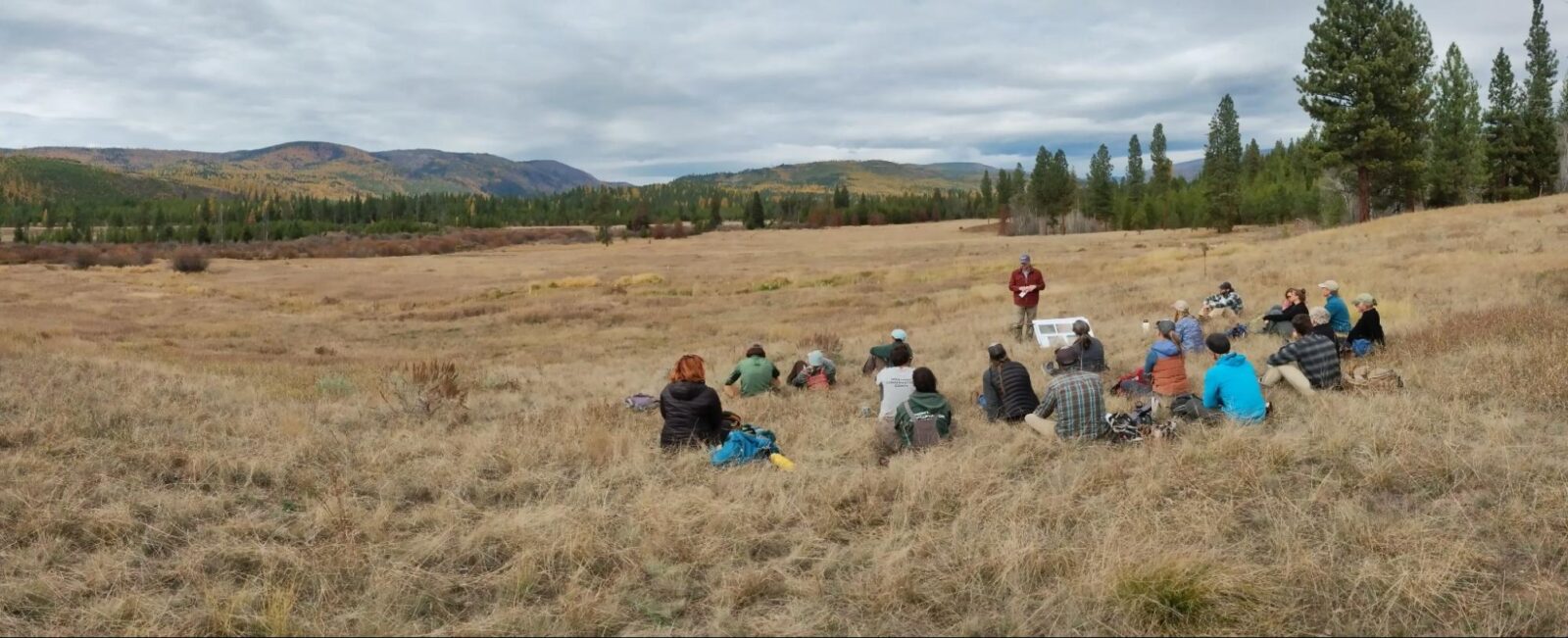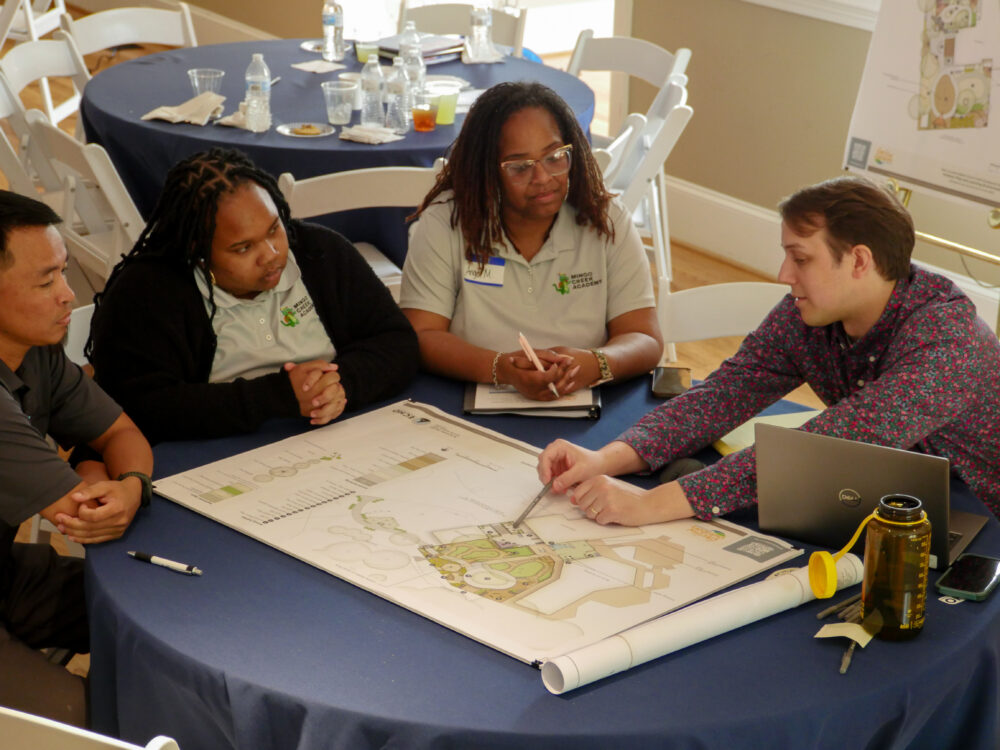We have much more to do and your continued support is needed now more than ever.
Low-Tech, High Reward
A Workshop Demonstrating Low-Tech, Process-Based Restoration in Action

The National Wildlife Federation, The Nature Conservancy, and Blackfoot Challenge teamed up with the Bureau of Land Management (BLM) to host a stream restoration workshop in the fall of 2023 to demonstrate collaborative stream restoration in one of western Montana’s most idyllic watersheds.
With the larch radiating gold as the backdrop, 16 workshop participants – representing local agencies, landowners, and conservation practitioners – meandered up the banks of Gold Creek, a tributary of the Blackfoot River. Following a diverse and saturated complex of beaver dams, they learned about the benefits of beaver and innovative restoration techniques alike. Natural beaver dams serve as a template for low-tech, process-based restoration (LTPBR) – which often mimics the work of beavers, one of nature’s greatest ecosystem engineers. “It’s like copy and paste,” said Claire Romanko (BLM), who helped lead participants through the beaver complexes as they made their way to Wild Horse Prairie.
The Montana Conservation Corps (MCC) crews had been working in the area for over a week installing LTPBR structures to restore Wildhorse Creek to some resemblance of the willowy wet sponge that Gold Creek is today. MCC has a specialized riparian restoration field crew, colloquially known as the “stream restoration strike team.” This group of eager young adults spent their summer working on stream restoration projects on public and private lands in Montana gaining hands-on experience of the ecological and economic importance of the western waters and wetlands. Members of this team can now be both implementers and ambassadors of this innovative approach to restoration.

As participants descended into Wild Horse Prairie, Steve Kloetze, Western Montana Land Steward with The Nature Conservancy, spoke about their collaboration with the Confederated Salish and Kootenai Tribes to restore the culturally-important camas plant back to these meadow systems. The presence of once extensive camas meadows in and around the Blackfoot Valley is demonstrated by remnant plants still visible in some seasonally wet meadows in the area. In the past, there were possibly hundreds or even thousands of acres of common camas plants within these meadow systems. After a quick lunch overlooking the vibrant larch forest, Steve Bennett from Anabranch Solutions and MCC crew leader, Frankie Freilich, described the “process” part of process-based restoration, gleaning insight from both the disciplines of fluvial geomorphology and on-the-ground experience of the inner workings of complex riverscape systems.
“Gold Creek offers a fantastic place to implement LTPBR because beaver are expanding in the mainstem due to suspending trapping, and installing BDAs [beaver dam analogs] in tributaries to Gold Creek can help entice beaver to recolonize the tributaries. This is an extremely efficient restoration because the beaver does most of the work!”
Steve Bennett, Anabranch Solutions
As participants moved downstream, Clancy Jandreau, from the Blackfoot Challenge, said the work happening on Gold Creek is a good example of how investing in a landscape can benefit not only wildlife, but local communities as well. Blackfoot Challenge is a local non-profit that focuses on community-led natural resource conservation by investing in rural communities.
This project, which is occurring on one of BLM’s recently identified 21 Restoration Landscapes, the Blackfoot-Clark Fork, showcases how partner-driven restoration – coupled with unprecedented federal investments from the Bipartisan Infrastructure Legislation (BIL) and Inflation Reduction Act (IRA) – can accelerate and amplify restoration benefits for local ecosystems and the communities and economies that depend on them by creating jobs and promoting wildlife resiliency.
The Blackfoot-Clark Fork Restoration Landscape has been allocated $9.54 million in IRA investments to focus on restoring these essential habitats by focusing on stream restoration, forest resiliency, recreation, road enhancement, and managing culturally-important resources through partnerships with local organizations and nonprofits like the Blackfoot Challenge.
The Gold Creek watershed is an important tributary to the Blackfoot River in western Montana, sustaining forestland and wildlife habitat on the edge of one of the state’s largest cities (Missoula) while supplying clean, cold water to one of the state’s most beloved rivers that supports nearby farmers and ranchers dependent on this vital resource.
Gold Creek and other tributaries in the region have undergone significant man-made stream manipulation since the 1800s when beaver trappers entered the area. Later, in the 1960s industrial timber companies began ridgeline to ridgeline timber extraction projects across the landscape. With the timber projects came large scale road building efforts; many of which were directly adjacent to streams. Over time, the removal of beavers and building of roads has changed the stream physical and biologic characteristics in these areas where water conveyance was valued over floodplain connectivity and “messy” wetlands habitat.

A Closer Look at Restoration Techniques
Low-tech, process-based restoration (LTPBR) is a technique designed to repair degraded streams in a simple, cost-effective manner. LTPBR can be as simple as changing management strategies (like in Gold Creek where beaver trapping has been suspended to allow beaver to recolonize the mainstem), to hand building structures that can mimic beaver dams or log jams. Structures that mimic beaver dams (called beaver dam analogs or BDAs) can collect water throughout the year, connecting the stream to its floodplain, recharging groundwater supply, and creating plant (riparian) communities more resilient to fire and drought.
LTPBR can also play a role in regulating water temperature by creating deep pools that provide safe habitat for aquatic life and promoting healthy riparian vegetation, which in turn stabilizes bank erosion, sustains habitat for wildlife, and extends the soil moisture content later in the season.
The importance of these structures becomes increasingly evident as we grapple with the impacts of climate change. They help create a more drought-resilient ecosystem supporting biodiversity and habitat complexity. Beaver-connected floodplains have been shown to create safe havens during wildfires, a benefit that is increasingly relevant in the face of climate change.
For more information on how NWF is working with local communities and partners in the face of drought, click here.

Looking Ahead
This workshop demonstrated the power and potential of LTPBR. The techniques and insights shared during the event offer a practical and cost-effective solution to the challenges posed by climate change and drought. The workshop served as a valuable platform for knowledge exchange and collaboration, bringing us one step closer to a future where our landscapes are more resilient and our ecosystems thrive.
As we continue to face the impacts of climate change, workshops like these are crucial in equipping landowners and managers of public and private lands with the tools and knowledge they need to restore lands and riverscapes to be resilient for the wildlife and communities that depend on them. The National Wildlife Federation, with its Beaver Conflict Resolution Program, and the collaborative efforts of other organizations – like The Nature Conservancy, Anabranch Solutions, LLC, Blackfoot Challenge and Bureau of Land Management – are leading the way in this important work.

To learn more about the Bureau of Land Management’s Restoration Landscapes, click here.





















